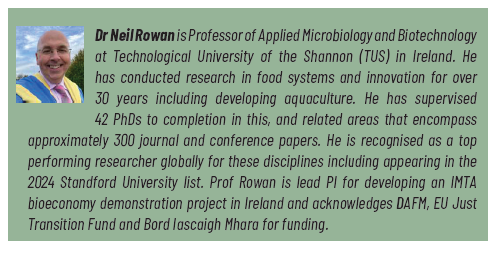Article II 3/2025 - REWETTED PEATLANDS FOR CO-CREATING RECIRCULATING AQUACULTURE AND FOR DRIVING AQUATECH – QUO VADIS?

In a recent networking event held in Athlone (Ireland) by Bord Iascaigh Mhara (Ireland’s Seafood Development Agency), emerging trends to drive key technology investment in aquaculture were presented by Hatch Blue that included (i) health and welfare improvements through diagnostic tools, feed additives and genetics; (ii) digitalisation and automation of farm data, water management and feeding systems; (iii) alternative ingredients exploration for more sustainable feed sources; and (iv) new farming systems, including intensification, offshore and underwater solutions. Thus, the availability of appropriate pilot and commercial demonstration at scale to help aquaculture will provide opportunities for co-creation and to de-risk for investment in innovation that includes meeting balanced environmental needs and concerns.
There is an emerging opportunity to avail of the rewetted peatlands to grow aquaculture internationally [7], which also enables communities to pivot away from reliance on using fossil fuels. Peatlands, which cover about 3% of our planet’s land surface [8], are water-saturated ecosystems of decomposing organic material referred to as “peat” [9]. Peatlands constitute the world’s largest terrestrial carbon stock, storing approximately 5 050 gigatonnes of carbon that is greater than the total carbon stored in forests globally [8]. Moreover, there is a growing opportunity to develop appropriate and effective recirculating aquaculture processes using rewetted peatlands that do not discharge efluent to the receiving environment [10]. A monitored and defined aquaculture system in the peatlands can be potentially operated to zerowaste, zero-pollution and climate action principles, as well as meeting food security needs [10].
One such example is an integrated multi-trophic aquaculture (IMTA) process, which is a type of aquaculture where the byproducts, including waste, from one aquatic species are used as inputs (such as fertilisers, food) for another. Farmers combine fed aquaculture (e.g., fish, shrimp) with inorganic extractive (e.g., seaweed) and organic extractive (e.g., shellfish) aquaculture to create balanced systems for environment remediation (biomitigation), economic stability (improved output, lower cost, product diversification and risk reduction) and social acceptability (better management practices) [1, 10].
Peatlands-based IMTA project in Ireland
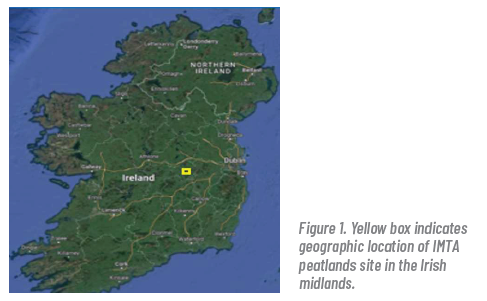
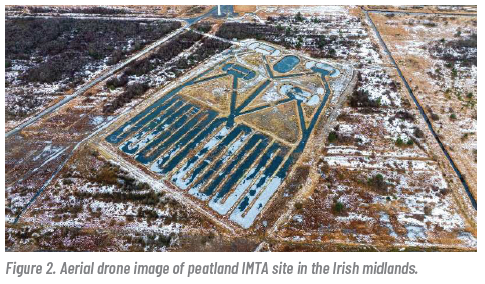
IMTA site demonstrates possibilities
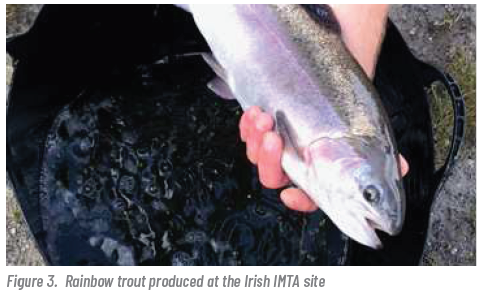
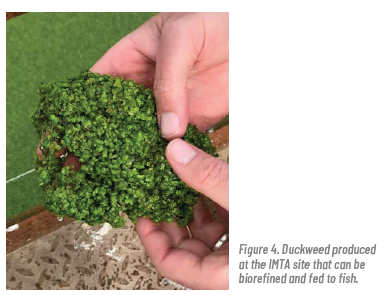
Interestingly, this IMTA framework also addresses the innovation gaps identified by Aidoo and Kwofie [16] for meeting their proposed conceptual “circular bioeconomy accounting tool”, which recognises the importance of fostering harmony between participating stakeholders and developing an appropriate integrative sustainability assessment relevant to solution design and performance monitoring. The Irish IMTA site considers use of public-private partnerships and change of land use under a fair and just transition for communities, farmers and other end-users[1].
Discussion
Optimising this IMTA peatland approach demands strategic design and effective management, including spatial arrangement for waste to disperse towards algal and aquatic plant (duckweed) growth areas, promoting interspecies relationships throughout the entire site [10]. Spatial design also involves the strategic placing of species in proximity to each other, such as filter feeders adjacent to fish to use waste nutrients. The roles of subject-matter experts on site is crucial, such as environmental (civil) wastewater engineers; this ensures effective managing of water and waste flow for facilitating nutrient exchange and maintaining optimised growth conditions for all trophic species. This includes creating the best conditions for natural filtration capabilities of certain trophic species. Moreover, the site should exhibit stable hydrology, appropriate pH levels, and minimal pollution to support these diverse aquaculture species.
This IMTA process will contribute to restoring degraded peatlands into their natural state, thus facilitating carbon sequestration and an ecological balance that also mitigates against the use of unwanted chemicals [15]. Other successful examples of IMTA systems have been reported globally, such as fish farming in combination with reed bed filtration systems in the United Kingdom [17]; integrating shrimp farming with mangrove restoration in Indonesia that reduces erosion and augments carbon sequestration [18]; and combining salmon farming with seaweed and mussel cultivation in Canada’s Atlantic region [19] to improve nutrient recycling and environmental impact.
The Irish government has taken steps towards turning Ireland into a global bioeconomy leader, promoting access to Mount Lucas as a national demonstration site for aquaculture and aquatech with a linked bioeconomy theme [1]. The strategic policies in Ireland that have global relevance include boosting employment and new business opportunities in rural, regional, urban, and coastal areas through innovation products, services and technologies; increasing food and energy security; supporting climate action by displacing fossil fuels; promoting a circular economy and reducing waste; providing high-value diversification opportunities for transforming agrifood systems; and leveraging research, development and innovation capabilities to address bioeconomy, societal and environmental challenges [20). The pivotal role of integrated demonstration facilities in developing tangible biobased opportunities at scale (including digital transformation) has yet be described [16, 21].
Defining a circular IMTA in the peatlands for production of trout, microalgae and macroalgae biomass provides an excellent example of a tangible “in action model” that can be replicated globally [15]. The mortality on site in the production of trout in Irish peatlands is very low [1]; however, the site is exposed to the elements where it has experienced significant challenges in managing the effects of successive storms and variance in weathering. Thus, this site also enabled modelling and prediction as to the impact of changing weather events and patterns on open food ecosystems, to both understand and mitigate against the impact of climate change [15].
The IMTA site will be connected fully to digital sensors to facilitate the optimal reuse of waste and sludge. In addition, there will be an onsite extended reality suite that enables 360° visualisation of the site operation, including the remote development of bespoke aquatech innovation. Such a defined IMTA system is in sync with the environment where profiling of different tropic levels enables eco-labelling (green) for new products that are compliant with ecology and with nature. The IMTA site at Mount Lucas does not rely on the use of pesticides or antibiotics, nor the complex use of physical technologies for end-of-pipe solutions for treating efluent. Developing such IMTA sites in the peatlands creates new exciting opportunities in terms of usage, while educating our next generation of change-makers for a cleaner resource-eficient world.
Summary
The IMTA site, operated through a subject matter expert approach in aquaculture, also facilitates tailored support and messaging to endusers for bespoke needs. This includes digital transformation and the emergence of artificial intelligence and machine learning for new innovation [23, 24, 25]. The remoteness and complexity of this peatlands IMTA site offers enormous potential for discovery of new species of microalgae due to its exposure and tolerance of harsh environments [10] that can lead to the biorefinery and production of novel new products. The site operates at the interface between serving innovator/entrepreneur demonstrator needs and interpreting/informing top-down strategic policies for food production and security that will also help sustainable development, given current economic and geopolitical turmoil.
For example, use of next-generation sequencing and bioinformatics of pond samples revealed a combined total of 982 species from 341 genera across nine phyla [10]. This is a remarkable and exciting commercial screening opportunity (such as for cosmetic, pharma and biotech applications), given that use of conventional microscopy revealed only 20 or so different species. Duckweed that is produced based on use of waste stream and cascades in IMTA channels can be harvested and biorefined on site, where it comprises about 30% protein available for animal or human feed [1]. The aforementioned highlights the opportunities for co-creation and innovation using a defined freshwater aquaculture site where new species within an IMTA ecosystem can also potentially be discovered depending on future geographic locations of peatland rewetting and replication of process. The nexus to supporting education and training programmes, including for communities interested in upskilling and in social enterprises, is apparent and transformative.
In summary, the co-creation of such a peatlands-IMTA site enables new innovation to be developed and tested in a defined ecosystem that also accelerates the need to understand and address key pressures, including meeting biodiversity along with demonstrating at scale for viable business propositions. This holistic IMTA site also enables development of aquaculture that will help policymakers understand and tailor strategic policies relevant to regions and bespoke needs. Such a defined system that embraces open data-sharing will enable replication in other geographic regions; however, considerations such as use of native species of duckweed, fish species and ecology will need to be carefully considered. Furthermore, the integration of education enables and supports longevity as it provides a framework to create an ecosystem of a new highly trained workforce equipped with cross-disciplinary skills.
References
- Rowan N.J., Fort A, O’Neill EA, Clifford E, Jansen M, Helfert M, Toner D, Maguire J, Tiwari B. (2024) Development of a novel recirculatory multitrophic peatland system for the production of high-value bio-based products at scale embracing zero waste and pollution principles to unlock sustainable development goals. Case Studies in Chemical and Environmental Engineering Jun;9:100763. Available from: https://linkinghub.elsevier.com/retrieve/pii/S2666016424001579
- Tschirner, M., Kloas,W. (2017) Increasing the Sustainability of Aquaculture Systems: Insects as Alternative Protein Source for Fish Diets. Ecological Perspectives for Science and Society, Vol 26 (4), 332-340.
- Faulkner, J.P., Murphy, E., Scott, M. (2024). Downscaling EU bioeconomy policy for national implementation. Cleaner and Circular Bioeconomy, Vol. 9, https://doi.org/10.1016/j.clcb.2024.100121
- Richter, S., Szarka, N., Beama, A., Thran, D. (2025). Enhancing the circular bioeconomy transition in Germany: A systematic scenario analysis. Sustainable Production and Consumption. 53, 125-146.
- ResearchandMarkets (2023) https://www.globenewswire.com/news-relea se/2024/08/23/2934836/28124/en/Aquaculture-Global-Strategic-Business- Report-2023-2030-Developing-World-Adopts-Aquaculture-to-Ward-off- Malnutrition-Presents-Significant-Growth-Opportunities.html (accessed 11th March, 2025)
- Yue, K., Shen, Y. (2022). An overview of disruptive technologies for aquaculture. Aquaculture and Fisheries, Vol 7 (2), 111-120.
- O’Neill, E.A., Stejskal, V., Paolacci, S., Jansen, M.A.K. and Rowan, N.J. (2024). Quo vadis - Development of a novel peatland-based recirculating aquaculture multi-trophic pond system (RAMPS) in the Irish midlands with a global orientation. Case Studies in Chemical and Environmental Engineering, 9, https://doi.org/10.1016/j.cscee.2024.100748
- IUCN UK (2024) About peatlands. https://www.iucn-uk-peatlandprogramme. org/about-peatlands#:~:text=Peatlands%20cover%203%25%20of%20 the,in%20all%20the%20world’s%20forests. (accessed 15 Feb, 2025)
- Tanneberger, F., Appulo, L., Ewert, S., Lakner, S., Ó Brolcháin, N., Peters, J. and Wichtmann, W., 2021. The power of nature-based solutions: how peatlands can help us to achieve key EU sustainability objectives. Advanced Sustainable Systems, 5(1), p.2000146.
- O’Neill, E.A., Fehrenbach, G., Murphy, E., Alencar, S.A., Pogue, R. and Rowan, N.J. (2022b). Use of next generation sequencing and bioinformatics for profiling freshwater eukaryotic microalgae in a novel peatland integrated multi-trophic aquaculture (IMTA) system: Case study from the Republic of Ireland. Science of the Total Environment, 851 (2), https://doi.org/10.1016/j. scitotenv.2022.158392
- Galanakis, C.M., Rizou, M., Aldawoud, T.M.S., Ucak. I. and Rowan, N.J. (2021). Innovations and technology disruptions in the food sector within the COVID-19 pandemic and post-lockdown era. Trends in Food Science and Technology, 110, 193
- Bord Na Mona Accelerate Green (2024). An executive accelerator designed to scale your sustainability-driven business.https://accelerategreen.ie (accessed 16th Feb, 2025)
- Huguenin, A., Jaennarat, H. (2017). Creating change through pilot and demonstration projects: Towards a valuation policy approach. Research Policy, Vol 46 (3), 624-635
- Nissar S, Bakhtiyar Y, Arafat MY, Andrabi S, Mir ZA, Khan NA, Langer S. The evolution of integrated multi-trophic aquaculture in context of its design and components paving way to valorization via optimization and diversification. Aquaculture [Internet]. 2023 Feb;565:739074. Available from: https://linkinghub.elsevier.com/retrieve/pii/S0044848622011917
- O’Neill, E.A., Stejskal, V., Paolacci, S., Jansen, M.A.K. and Rowan, N.J. (2024). Quo vadis - Development of a novel peatland-based recirculating aquaculture multi-trophic pond system (RAMPS) in the Irish midlands with a global orientation. Case Studies in Chemical and Environmental Engineering, 9, https://doi.org/10.1016/j.cscee.2024.100748
- Aidoo, R., Kwofie, E.M. (2024). Circular bioeconomy account tools (CBEAT): A holistic framework for agriculture and agri-food system circularity practice. Sustain Sci. https://doi.org/1007/ss11625-024-01578-3
- Fletcher, S., Saunders, J., Herbert, R., Roberts, C., Dawson, K. (2012). Description of the Ecosystem Services Provided by Broad-Scale Habitats and Features of Conservation importance: They are likely to be protected by Marine Protected areas in the Marine Conservation Zone Project area. Natural England Commissioned Reports, Number 088, York, England.
- Sakinah, L. (2024), Putting Indonesia’s aquaculture sector on the map. The fish site. https://thefishsite.com/articles/putting-indonesia-aquaculturesector- on-the-map-ita-sualia (accessed 21 January, 2025).
- Van Beijnen, J., Yan, G. (2024). The multi-tropic revolution: A deep dive with IMTA Guru Thierry Chopin. The fish site. https://thefishsite.com/articles/ the-multi-trophic-revolution-a-deep-dive-with-imta-guru-thierry-chopinpolyculture- salmon-mussels-seaweed (accessed 21 December, 2025)
- International Advisory Council on Global Bioeconomy (2024). Bioeconomy
globalization: recent trends and drivers of national programs and policies.
https://www.iacgb.net/lw_resource/datapool/systemfiles/elements/
files/52440fb0-f35d-11ee-9ed1-dead53a91d31/current/document/Global_
Bioeconomy_-_April_2024_IACGB.pdf (accessed 13 Dec, 2024) - McBride, O. (2024). Shared Island Bioeconomy Demonstration Initiative Launched. The Fishing Daily. https://thefishingdaily.com/latest-news/ shared-island-bioeconomy-demonstration-initiative-launched/ (accessed 15 December, 2024)
- Rowan, N.J. and Casey, O. (2021). ‘Empower Eco’ multi-actor HUB: A triple helix ‘academia-industry-authority’ approach to creating and sharing potentially disruptive tools for addressing novel and emerging new Green Deal opportunities under a United Nations Sustainable Development Goals framework. Current Opinion in Environmental Science and Health, 21, https:// doi.org/10.1016/j.coesh.2021.100254
- Rowan, N.J., Murray, N., Qiao, Y., O’Neill, E., Clifford, E., Barcelo, D. and Power, D.M. (2022). Digital transformation of peatland eco-innovations (‘Paludiculture’): Enabling a paradigm shift towards the real-time sustainable production of ‘green-friendly’ products and services. Science of the Total Environment, 838 (3), https://doi.org/10.1016/j.scitotenv.2022.156328
- Rowan, N.J. (2023). The role of digital technologies in supporting and improving fishery and aquaculture across the supply chain – Quo Vadis? Aquaculture and Fisheries, 8 (4), 365-374.
- Rowan, N.J. (2024). Digital technologies to unlock safe and sustainable
opportunities for medical device and healthcare sectors with a focus
on the combined use of digital twin and extended reality applications: A
review. Science of the Total Environment, Vol 926, https://doi.org/10.1016/j.
scitotenv.2024.171672 - Paolacci, S., Stejskal, V., Toner, D., Jansen, M.A.K. (2022). Wastewater valorisation in an integrated multitrophic aquaculture system: Assessing nutrient removal and biomass production by duckweed species. Environmental Pollution, Vol. 302, https://doi.org/10.1016/j.envpol.2022.119059
